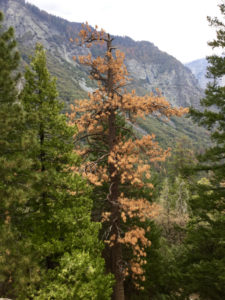 California’s forests are dying with help from a little insect less than ¼ inch long. So the state’s TV channels are airing a clip sponsored by Cal Fire, California’s firefighting arm. In it, Cal Fire warned state residents,
California’s forests are dying with help from a little insect less than ¼ inch long. So the state’s TV channels are airing a clip sponsored by Cal Fire, California’s firefighting arm. In it, Cal Fire warned state residents,
“Don’t let your guard down after this year’s wet winter. Rain can’t revive the millions of trees that are dead from years of drought. The bark beetle epidemic continues infesting and killing even more trees. The more dead trees, the greater the threat from wildfire …”
Californians are directed to its website, ReadyforWildfire.org, for additional details.
From Bad to Worse
And California is not alone. In western Canada and the United States many trees are already dead. Many more soon will be.
The producers of a 2005 report titled Bark Beetle Outbreaks in Western North America: Causes and Consequences stated,
“Although bark beetle infestations are a regular force of natural change in forested ecosystems, several of the current outbreaks, which are occurring simultaneously across western North America, are the largest and most severe in recorded history.”
Meanwhile, in the last 10 plus years the bark beetle epidemic has continued to expand. According to a April 2015 National Geographic article.
“Now they’re spreading east across Canada.”

Dead tree needles change from green and slowly fall off
Normally, says the Bark Beetle Outbreaks report,
“Bark beetles help to winnow out old and mature trees so that younger, more productive trees can replenish an aging forest”
However, it expressed that now,
“ … scientists are concerned that the current levels and rates of tree mortality in some forest ecosystems may be pushing these systems beyond their ability to recover and regenerate.”
Other Ramifications
National Geographic warned its readers,
“The trees aren’t the only casualties. A forest die-off disrupts everything, from food webs to local economies. … in Yellowstone National Park bears and birds have lost a rich source of nutrition. … With nothing to anchor it, soil washes away.”
As this forest die off continues, wild animals – like mountain lions, bears, and coywolves – are also increasingly likely to seek food where humans and their domestic animals are.
Such an incident was covered in an US News and World Report article dated April 15, 2016.
“Students and teachers at a Los Angeles high school missed their lunch break Friday after a mountain lion strolled onto campus and tried to join them.”
Andrew Hughan, state Department of Fish and Wildlife spokesman, told the magazine,
“Mountain lions wander into cities somewhere in California every few weeks”
For additional information on coywolves and other wild animal attacks, see our April 23, 2015 article.